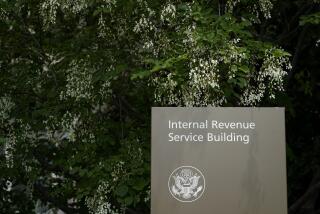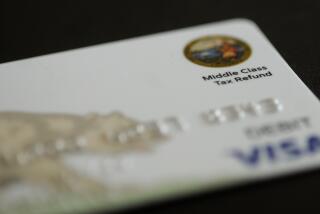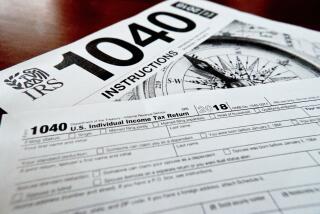Software heads off potential tax cheats
Most American taxpayers are likely to get an extra $30 to $60 in their refund checks this year, thanks to a one-time credit available to anyone who made long-distance phone calls.
But nine people whose returns were filed electronically from a Riverside halfway house for drug and alcohol abusers last month sought phone-tax refunds totaling $439,632 -- an average of $48,848 each, according to the Internal Revenue Service.
Fat chance, tax investigators said. That amount in refunds would have required long-distance bills topping $12 million.
The alleged phone-tax credit swindle is the latest in a long line of attempted scams that bedevil tax collectors every year. In the past, IRS officials concede, the government might actually have paid out the money and asked questions later. By the time a fraud was discovered, the perpetrators might well have moved on.
This time, however, IRS investigators served search warrants on the halfway house Feb. 12 and seized records that authorities believe will lead to tax fraud charges. Officials credit the quick action to new computer programs that flag suspicious returns when they are filed electronically.
“We knew there was a potential for this [fraud] to happen with the telephone excise tax,” said Terry Lemons, an IRS spokesman. “We were able to get everything lined up to monitor it, and you are seeing the results of that.”
The programs were adopted after criticism that the tax agency was letting too much revenue slip away. The IRS estimates it was shortchanged $345 billion last year alone through deceits or errors, much of which is unlikely to be recovered. (The agency recouped $49 billion through enforcement and collection in the 2006 fiscal year that ended Sept. 30.)
The new software appears to be making a dent in the problem.
In 2003, there were 97,000 suspect claims seeking $349.5 million in questionable refunds that the IRS was able to spot before refund checks were issued. In 2005 (the most recent year available), the agency headed off refund checks totaling $515.5 million from 133,000 suspect returns.
“They have increased their capacity to use information quite substantially,” said Michael Brostek, director of tax issues at the Government Accountability Office in Washington. “They check a lot of pieces of the tax return that they simply couldn’t check before.”
Widespread tax fraud is nothing new. In the 1980s, Congress began requiring that taxpayers provide Social Security numbers for each dependent claimed as a tax exemption, in response to suspicions that people were claiming pets and others as fictitious dependents.
The following year, 5 million dependents mysteriously disappeared.
In the 1990s, tens of thousands of taxpayers claimed a “slavery reparation” credit, according to the IRS. In fact, there had been several bills in Congress to explore providing restitution to people whose ancestors were slaves, but the legislation never passed.
The IRS was unable to say how much that scam cost the U.S. Treasury, but the agency concedes it has paid millions of dollars in refunds to prison inmates who obtained tax forms from prison libraries and fabricated income statements -- a ploy one member of Congress dubbed “Operation H&R; Cell-Block.”
The problem is significant enough that the IRS has asked Congress for permission to contact prison officials with information about inmates who have filed fraudulent returns so they can head off future attempts. Normally the IRS is barred from sharing such information with other agencies.
“There are an increasing number of fraudulent refund claims filed by prisoners,” the IRS said in making the request, adding that threats of prosecution and imprisonment have little sway over people who are already incarcerated.
The Internet has made it easier for tax cheats and some anti-tax advocates to share schemes, which is one reason IRS officials say they anticipated a flood of fraudulent claims stemming from the telephone excise tax credit.
The one-time break for 2006 returns aims to refund the 3% federal tax, which was rescinded, on long-distance phone calls that people paid from February 2003 through August 2006.
The returns filed from the Riverside halfway house were flagged by IRS staffers in Washington, who contacted tax investigators in Los Angeles on Feb. 5, according to an affidavit filed to support the search warrant on the home.
Investigators tracked the computer to its owner, Peaches Mercer Turner, using the machine’s Internet protocol address, according to the affidavit. Turner, the owner of the halfway house, declined to be interviewed by The Times. No charges have been filed in the case.
IRS investigators said they interviewed the other taxpayers whose returns were filed with Turner’s computer. Most of them had been residents of her home at one time, including Eddie Atalima, who had a return citing wages of just $15,033 but claimed telephone tax credits amounting to $53,586, according to the affidavit.
Atalima said he asked a woman he identified as “Peaches” to help him prepare his return, investigators said. He said he was surprised to learn that he had two dependents (he’s single with no children) and was seeking a $58,927 refund.
For the claim to be legitimate, he would have had to have made $1.5 million in long-distance calls.






